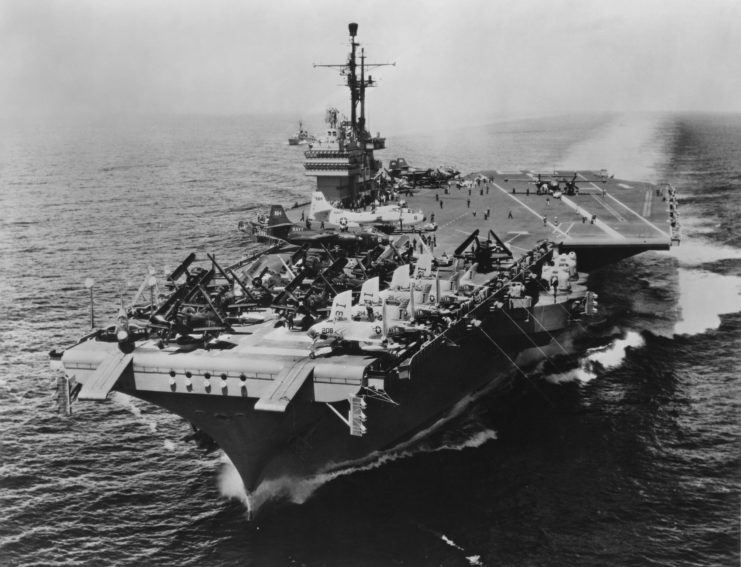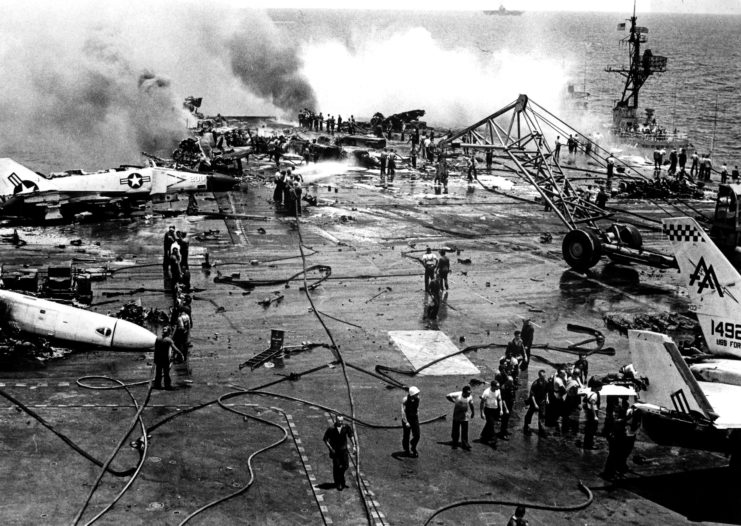The USS Forrestal (CV-59) operated in the US Navy for almost forty years, taking part in numerous combat missions. Yet, none were as well-known as the tragic accident on her flight deck in 1967, which led to huge loss of life and extensive damage to the aircraft carrier.
Amid the tragedy, there was one positive outcome: the Navy swiftly instituted training reforms in reaction to the incident.
The USS Forrestal‘s early service in the Atlantic and Mediterranean

The USS Forrestal was the lead ship in her class of aircraft carriers and was commissioned on October 1, 1955.She was the first carrier specifically designed to operate jet aircraft, marking her as the Navy’s first “supercarrier.”
Forrestal began her service in the Atlantic Ocean during the Suez Crisis and was assigned to the Mediterranean with the US Sixth Fleet. Before being deployed to provide extra airpower during the Vietnam War, she was stationed off the coast of Beirut during the 1958 Lebanon crisis for three days.
In November 1963, Forrestal made history when a Lockheed C-130 Hercules executed 21 full-stop landings and takeoffs on her deck, establishing a record for the largest and heaviest aircraft to land on a carrier. The following year, US President Lyndon B. Johnson sent the vessel to Brazil to aid the successful military coup d’état against President João Goulart.
The explosion on that fateful day

In June 1967, the USS Forrestal was deployed to the Gulf of Tonkin in the South China Sea, just off the coast of north Vietnam. While there, aircraft from Attack Carrier Air Wing 17 (CVW-17) flew a number of successful missions from the vessel, in what was then the most intense air raid operation in the Navy’s history.
On July 29, 1967, an electrical surge in one of the McDonnell Douglas F-4B Phantom IIs onboard Forrestal caused an Mk 32 “Zuni” Five-Inch Folding-Fin Aircraft Rocket (FFAR) to accidentally launch. It blasted across the deck and slammed into a parked, combat-loaded Douglas A-4E Skyhawk, dislodging its 400-gallon external fuel tank. Inside the aircraft was late Sen. John McCain, who was able to escape from the cockpit.
The impact of the rocket caused fuel from the A-4E to leak and catch fire. As the blaze spread, the first two firefighting teams were killed trying to contain the first explosion. Nine more blasts followed within the first five minutes of the initial rocket launch. Eventually, the fire spread enough to detonate a 1,000-pound AN-M65 bomb.
The losses onboard the USS Forrestal were devastating

The fire raged on, trapping pilots within their aircraft. A full day passed before authorities managed to contain the blaze, a task made arduous by the initial bomb detonation that ruptured the flight deck, enabling fuel to seep downwards into the USS Forrestal’s lower levels. Subsequent explosions further compromised the deck, resulting in the tragic demise of 50 crew members when one blast erupted directly above their sleeping quarters.
The valiant efforts of the destroyers USS Rupertus (DD-851) and George K. MacKenzie (DD-836) were crucial in finally quelling the flames, revealing the staggering extent of the casualties. Many wounded were transported to the hospital ship USS Repose (AH-16).
Tragically, the disaster resulted in the loss of 134 sailors, with hundreds more left injured. Additionally, over 20 aircraft, including F-4Bs, A-4Es, and North American RA-5C Vigilantes, were obliterated, leaving the aircraft carrier herself with damages exceeding $70 million.
Fires at sea present a terrifying predicament for sailors: confront the flames, succumb to the blaze, or leap into the unforgiving waters. There’s no sanctuary. While some aboard the Forrestal managed to survive the catastrophe, others met a crueler fate. The explosions marked the deadliest incident on a US Navy vessel since the Second World War.
The US Navy changed its training

Following the incident, the Navy undertook a comprehensive review of its firefighting training procedures, uncovering a permissive atmosphere, inadequate firefighting skills among sailors, and slow responses to unforeseen accidents.
Under the leadership of Rear Adm. Forsyth Massey, the Aircraft Carrier Safety Review Panel, which was responsible for investigating the tragedy, concluded that, “Poor and outdated doctrinal and technical documentation of ordnance and aircraft equipment and procedures, evident at all levels of command, was a contributing cause of the accidental rocket firing.”
In response to the events aboard the USS Forrestal, the Navy launched a major overhaul of its training regimen, incorporating new protocols and improvements. Despite the tragedy, the Navy gained crucial insights and implemented essential firefighting instruction for its sailors, which remains in use today. The goal was to prevent any recurrences of such an event.
The USS Forrestal remained in service for several years after

Surprisingly, the explosions on July 29, 1967, didn’t inflict enough damage to prevent the USS Forrestal from being repaired. Once cleared to return to duty, the aircraft carrier was deployed to the Mediterranean multiple times, participated in the 1981 Gulf of Sidra incident, took part in Operation Earnest Will in the Middle East and was placed on standby during the Gulf War.
After providing air support during Operation Provide Comfort in 1991, Forrestal transitioned into a training carrier and was re-designated AVT-59. In 1993, she was decommissioned. Twenty-three years later, in 2015, she was ultimately scrapped following unsuccessful efforts to convert her into a museum.
Are you a fan of all things ships and submarines? If so, subscribe to our Daily Warships newsletter!
Currently, a model of the vessel is exhibited in the “America’s War in Vietnam” section at the National Museum of the US Navy.
